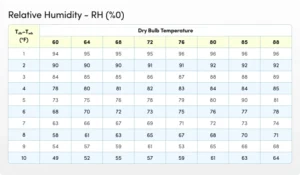Choosing the ideal flooring for your home or office entails more than just aesthetics. It’s crucial to consider the climate of your environment as it directly affects the humidity level in your indoor space. The indoor climate, whether it’s characterized by high or low humidity, significantly influences the durability and performance of different flooring materials. In this blog, we will delve into diverse climates and offer suitable flooring recommendations for both home and office settings. Additionally, we will provide do-it-yourself (DIY) tips and tricks to help you assess the humidity level in your space. Let’s embark on this journey together to discover the perfect flooring solution that aligns with the unique climate of your location!

Hot-Humid
In hot-humid regions, which receive over 20 inches of annual precipitation, both homes and offices are typically air-conditioned year-round. However, it’s crucial to choose flooring materials that can withstand moisture without compromising durability and appearance. Here are some recommended options:
Ceramic or Porcelain Tiles | These water-resistant tiles are ideal for high-humidity areas. They provide a cool surface and are easy to clean, making them perfect for hot and humid climates.
Luxury Vinyl | Combining the durability of tiles with the look of hardwood, luxury vinyl is an excellent choice for spaces with high humidity levels. Remember to use proper care and avoid abrasive chemicals for cleaning to prevent damage.
Mixed-Humid
In regions with mixed-humid climates, where precipitation is moderate and winter temperatures drop below 45°F, consider the following flooring options:
Engineered Hardwood | Engineered hardwood flooring is designed to handle temperature and humidity fluctuations better than solid hardwood. Its layered construction minimizes the risk of warping or buckling.
Laminate Flooring | Highly resistant to moisture, laminate flooring offers good durability. It can mimic the appearance of hardwood or other materials at a more affordable price.
Hot-Dry
For hot-dry climates with low annual precipitation, flooring options that can handle dry conditions are suitable. Consider the following choices:
Concrete | Polished concrete floors are an excellent option for hot-dry climates. They retain coolness and are resistant to moisture-related issues.
Ceramic or Porcelain Tiles | Tiles are an all-around versatile choice for various climates. In hot-dry regions, they remain unaffected by low humidity levels and provide a cool surface underfoot.
Mixed-Dry
In regions with mixed-dry climates, where both moisture and lower temperatures are a concern, these flooring options can be considered:
Cork Flooring | Cork is known for its natural moisture resistance and ability to insulate against temperature changes. It is comfortable to walk on and offers a unique aesthetic appeal.
Bamboo Flooring | Bamboo is an eco-friendly flooring option that can handle moisture fluctuations better than traditional hardwood. It adds warmth and elegance to any space.
Measuring Indoor Humidity
If you suspect that the humidity levels in your indoor space are not within the desired range, it’s important to take steps to adjust them accordingly. Maintaining the appropriate humidity level is crucial for your comfort and to prevent potential issues caused by excessive moisture or dryness. To measure the relative indoor humidity level accurately, the easiest method is to use a hygrometer. This device measures both humidity and temperature and provides a straightforward way to monitor the humidity in your home or office. If you don’t have a hygrometer, here are two alternative methods you can try:
The Ice Cube Method
- Fill a glass with water and add two to three ice cubes.
- Leave the glass undisturbed for about four minutes.
- Check the outside of the glass for condensation.
- If condensation is forming or dripping, the humidity levels may be too high.
- If there is no condensation, the humidity levels may be too low.
Tip: Avoid performing this test in the kitchen, where cooking vapors can affect the results. Also, leave the room after placing the ice cubes to prevent air currents from influencing the outcome.
The Wet and Dry Bulb Thermometer Method
- Prepare two regular glass thermometers.
- Leave one thermometer as is (dry bulb) and wrap a wet cotton ball around the bulb of the second thermometer (wet bulb).
- Secure the cotton ball with a rubber band and moisten it with room-temperature water.
- Place both thermometers side-by-side on a piece of cardboard.
- Leave the room undisturbed for five minutes.
- Check and record the temperatures on both thermometers.
- Subtract the wet-bulb temperature from the dry-bulb temperature to find the depression value.
- Use the chart below to compare the depression value to the relative humidity:

Finding Your Comfort Level
The ideal indoor humidity levels vary by season. In general, the following guidelines can help you maintain comfortable humidity levels:
Summer | Aim for 40-50% relative humidity. Humidity levels above 60% can make your home feel moist and muggy.
Winter | Target 30-40% relative humidity. Higher humidity during winter can lead to condensation on windows.
How to Decrease Indoor Humidity Levels
- Use exhaust fans to reduce excess moisture.
- Utilize a dehumidifier to remove moisture from the air.
- Introduce indoor plants, which naturally absorb excess moisture.
- Avoid boiling water on the stove, as it adds moisture to the air.
- Take shorter showers or use cooler water.
- Dry clothes outdoors to prevent adding moisture to the indoor air.
- Keep air conditioning filters clean.
How to Increase Indoor Humidity Levels
- Use a large room or whole-home humidifier to release moisture into the air.
- Hang wet clothes indoors to allow the moisture to evaporate into the air.
- Incorporate houseplants, which release moisture through transpiration.
- Shower with the bathroom door open to release steam into the air.
- Place open containers of water near vents.
- Cook on the stove, especially dishes that require boiling water.
- Use a spray bottle of water to increase moisture in the air.
By monitoring and managing indoor humidity levels, you can ensure a comfortable and healthy environment in your home or office throughout the year. Low humidity can result in dry skin, increased susceptibility to infections, and potential damage to wood floors and furniture. On the other hand, high humidity fosters the rapid growth of mold, can cause warping of wooden structures, and creates an uncomfortable, muggy atmosphere indoors. If you notice persistent issues with humidity, it’s advisable to consult with a professional or HVAC specialist who can provide further guidance and solutions.
Remember, the indoor climate of your home or office, particularly the humidity level, plays a crucial role in determining the best flooring choices for each room. From ceramic tiles and luxury vinyl in high-humidity areas to engineered hardwood and laminate flooring in mixed-humid climates, considering the specific climate of your space will help you make an informed decision. Each flooring material has its own set of advantages and limitations, so choose wisely based on your climate zone and the preferences of your home or office. If you need help selecting the right flooring for your space, don’t hesitate to get in touch with us at ACSpro@acsouth.com.